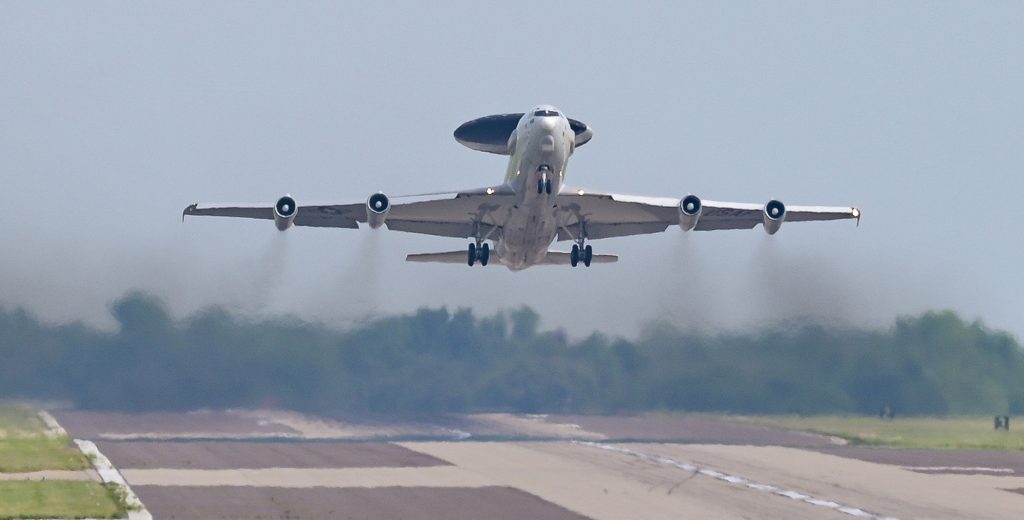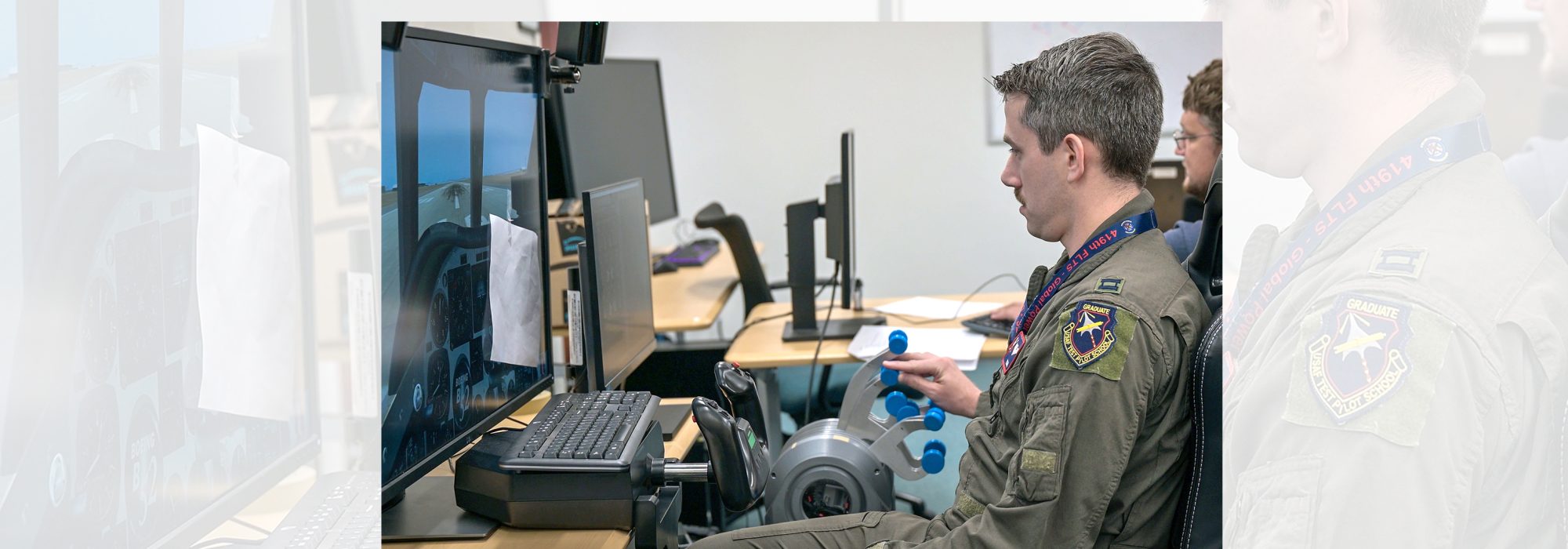By David Roza
As the B-52 fleet prepares for new engines, radar, and other tech upgrades, a team of test pilots and engineers at Edwards Air Force Base, Calif., is hard at work making the legacy bomber easier to operate for future crews.
New digital engine gauge clusters will replace legacy analog gauges, displaying fuel flow and exhaust temperature for each of the B-52’s eight engines, so pilots can more easily anticipate problems and identify malfunctions. The goal is to make the cockpit more intuitive so pilots are better able to focus on mission.
“Flying the airplane is the first step and using it as a weapon system is the ultimate step,” said Lt. Col. Scott Pontzer, commander of the 419th Flight Test Squadron and director of the Global Power Bombers Combined Test Force. “So if I can lower workload for the pilot … I can lower that overall task on the brain.”
Today’s attention to human systems integration, where systems are designed to support the operator rather than making operators learn an unintuitive system, did not exist in the 1940s, when the first B-52 cockpit was designed, said Dave Prakash, a former B-52 operational test pilot and flight surgeon.
“Whether it’s the engine instruments or the navigation instruments, they are all designed to fit compactly in the space there, but they are not designed to be easy to use,” he said.
For example, pilots routinely perform cross-checks, where they rapidly check their airspeed indicator, vertical velocity indicator, bank angle, and other instruments in order to make a decision. Time is critical, especially during night landings or flying in inclement weather. But the way the B-52 cockpit was originally laid out costs precious half- and quarter-seconds.
“The instrument clusters are not designed in the most efficient way for a pilot to do a cross-check,” Prakash said. “The gauges and instruments are not even consistent between the left and right pilots’ seats. So you have to do a different cross-check depending on which seat you’re in.”
The problem extends to the engine gauges, which display engine pressure ratio (EPR), fuel flow, exhaust gas temperature, revolutions per minute (RPM), and oil pressure. During his time as a test pilot, Prakash analyzed how those and other systems like navigation might be optimized for the operator.
“If there are 20 button pushes required to do one thing, is there a way to make it into just two button pushes?” he asked.
The test team at Edwards is working on those questions at the same time as the B-52 Commercial Engine Replacement Program comes online. The shift to digital gauges should make it easier for operators to rapidly check the new engines.
“This provides better accuracy, readability, and error indications, to name a few things,” Maj. Darin Flynn, a B-52H test pilot with the 370th Flight Test Squadron, told Air & Space Forces Magazine. “We also have EPR demand pointers which greatly reduces workload during precise throttle setting.”
Pilots tested out three different prototype gauge clusters in a simulator, then filled out a questionnaire to record their preferences.
“We are actually measuring their performance on these displays and we’re getting really good comments too, because now they’ve actually seen what the displays look like,” Flynn said in a release. “That’ll help us to select hopefully the best design choice for the B-52.”
The new B-52 engines are militarized versions of Rolls-Royce’s commercial BR725, and the software in the B-52J will be a mix of commercial and military software, explained Flynn and Eric Treadwell, B-52 crew systems/human factors lead. Beyond the engine gauge clusters, the entire cockpit is getting a makeover as analog displays are replaced with large, color, multifunction screens.
There are still some dangers in better technology: Prakash warned that issues may arise from automation bias, which is when users do not notice failures in automated decision-making systems—think of autocorrect features on your phone—or when users become desensitized to alarms and warnings and then fail to recognize real danger.
“I don’t think automation bias will really be too much of a factor,” he said. “We have different levels of alerts that will be displayed or inhibited depending on their severity and phase of flight,” Flynn said. “We have already identified some warnings that are commercial in nature and not applicable to military use.”
Going forward, the team at Edwards hopes to collaborate with maintainers to get their input on the digital instruments and how those changes affect their work.
“We can solve problems before they ever become problems,” Pontzer said.
13th AWACS Jet Flies West to Boneyard

By Greg Hadley
The Air Force’s E-3 Sentry AWACS fleet is down to just 18 aircraft with the retirement of the last of 13 aircraft to be divested from Tinker Air Force Base, Okla., this year.
The jet left Tinker for the “Boneyard” at Davis-Monthan Air Force Base, Ariz., on Sept. 21. Of the 13 jets, a dozen AWACS aircraft went to Davis-Monthan over the past six months; the remaining one will remain as a static display at Tinker.
That leaves fewer than 15 AWACS still active at Tinker, which has long been the Air Force’s main hub for E-3s. The other remaining airframes are assigned to Joint Base Elmendorf-Richardson, Alaska, and Kadena Air Base, Japan.
Divesting part of the fleet will improve sustainability by adding high-demand, low-availability parts back into the supply chain,” the wing said in a release. That should yield at least temporary improvement for overall aircraft availability. E-3 mission-capable rates plunged below 65 percent in recent years, largely because they’re based on a 707 airframe that first flew in 1957 and has long been commercially obsolete. The Air Force’s AWACS fleet averages more than 40 years old.
Air Combat Command boss Gen. Mark D. Kelly called the E-3s “unsustainable without a Herculean effort” last year, praising “miracle worker” maintainers for getting the aircraft to fly at all.
The Air Force plans to replace the E-3s with new E-7 Wedgetail aircraft, based on the Boeing 737.
The Air Force formally awarded a contract to Boeing for the E-7 Wedgetail in late February, clearing the way for the AWACS retirements to begin. Looking ahead to 2024, the Air Force plans to divest two more AWACS to reach its original goal of 15 aircraft divestments.
“The E-3 is a legacy airframe which can’t compete in a peer or near-peer conflict and cannot be modified to be part of the next generation of Command and Control (C2)/Airborne Moving Target Indicator (AMTI) systems,” Pentagon budget documents state.
The departures from Tinker are bittersweet for Airmen who spent years working in and on the venerable aircraft. The 552nd Air Control Wing noted in a release that Martha “Fran” Stephens, one of the first women to work on the AWACS, got to tour tail number 83-0009 before it departed Sept. 21.
“If someone tells you they worked on an AWACS, that probably means they worked like a dog,” said Stephens. “They should be respected for that.”
